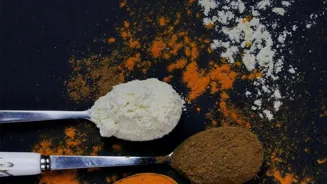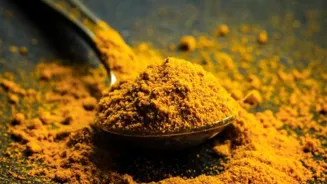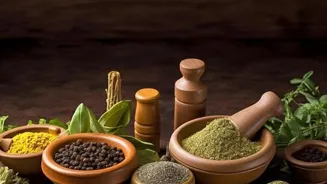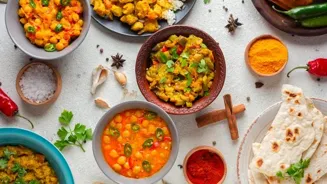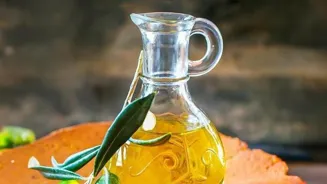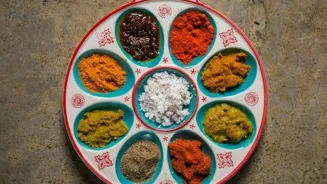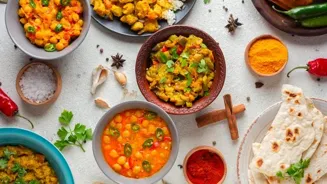Unravel the secrets to crafting delectable Indian curries! Dive into the essence of aromatic base ingredients. Explore more!
Indian cuisine, especially its curries, is famous globally for its rich flavors
and amazing aroma. But for many home cooks, creating that authentic taste can seem tricky. The secret is understanding the foundational ingredients that build the flavor profiles of most Indian vegetarian curries.
This article will break down these base elements, helping you create delicious and satisfying vegetarian Indian meals right in your own kitchen. Let's remove the mystique and dive into the heart of Indian flavor!
Main pillar of Indian curry: choosing the right cooking oil
The first pillar of Indian curry is a well-chosen cooking oil. While traditionally ghee (clarified butter) was preferred, vegetable oils like sunflower, groundnut, or even mustard oil (especially in North India) are commonly used today.
The choice depends on your preference and the type of curry you're making. Ghee gives a richer, nutty flavor, while vegetable oils offer a neutral base, allowing the spices to shine through. Heating the oil properly is crucial.
It should be hot enough to sizzle when you add the next ingredients, but not so hot that it burns them. This step releases the aromatic compounds and initializes the cooking process well. Don't underestimate the importance of good quality oil; it can significantly impact the final taste!
Remember a generous amount of oil helps to sauté the initial spices and ingredients and blend well.
Essential spices for Indian curry: cumin, mustard, asafoetida
Next, come the aromatic spices – the soul of any Indian curry. The holy trinity in most vegetarian dishes includes cumin seeds (jeera), mustard seeds (rai), and asafoetida (hing).
Cumin adds an earthy, warm flavor, mustard seeds offer a pungent kick that releases when they pop, and asafoetida provides a unique, savory "umami" depth. These spices are almost always added to the hot oil first.
The order matters: start with mustard seeds until they splutter, followed by cumin seeds to release their aroma, and then add hing quickly as it can burn easily. This process, called tempering or "tadka", is critical.
It extracts the essential oils from the spices, infusing the oil with their flavors, ultimately building the base notes for your curry. Other aromatics like bay leaves, cloves, cinnamon sticks, and cardamom pods can also be added at this stage, depending on the specific recipe.
These spices have to be used in whole form for the flavors to blend well.
Onion, garlic, ginger create essential base for Indian curries
Moving on to the alliums – onion, garlic, and ginger which form another critical layer of flavor. These three ingredients, when cooked slowly and properly, create a sweet, savory base that underpins most Indian curries.
Onions are usually the first to go in, cooked until they turn a light golden brown – this takes time and patience, but the sweetness that develops is essential. Next comes ginger-garlic paste. Freshly made paste is always preferred; the pre-made variety lacks the vibrant flavor.
Sauté the paste until the raw smell disappears and it starts to brown slightly. The proportion of these three ingredients varies, but a standard ratio is often roughly 2:1:1 (onion: ginger: garlic). Remember to stir frequently to prevent burning, and adjust the heat as needed.
The slow cooking of this trio is what releases their sweetness and takes away the astringency, creating the base flavor layer upon which other ingredients are built. Remember that the proper process to add them is onion the ginger garlic paste respectively.
Powdered spices define curry's character; add after sautéing base
Now come the powdered spices, the heart and soul in defining the unique character of your curry. These spices are typically added after the onion-ginger-garlic base is well-sautéed to avoid burning.
The most essential ones are turmeric powder (haldi), coriander powder (dhania), and red chili powder (lal mirch). Turmeric gives a yellow color along with medicinal properties. Coriander powder adds an earthy, citrusy flavour and functions to thicken the curry.
Red chili powder gives the level of heat. Add these spices and sautéing them briefly until you get their respective fragrance. Spices like garam masala, cumin powder, dry mango powder (amchur), are added further to add more flavour to the curry. Remember to roast and grind whole spice.
This makes the spices more aromatic to be used in the curry. Proper blending of powdered spices is important to build flavour in the curry.
Vegetables and lentils form the bulk of vegetarian curry
Next, the vegetables and lentils are added. This is the stage where the bulk of the curry comes together. The choice of vegetables depends entirely on the recipe. Potatoes, cauliflower, peas, spinach, eggplant, okra, and paneer are all popular choices in vegetarian curries.
Lentils like dal are a good source of protein in a vegetarian meal. Remember to pre-soak your lentils before cooking to ensure they cook evenly and quickly. Before adding any water, sauté the vegetables or lentils with the spice base for a few minutes.
This helps them absorb the flavours of the spices better. Then add water to reach your desired consistency. The cooking time will vary depending on the vegetables. Potatoes and lentils will take longer than spinach or okra. Once they are well cooked, the curry becomes the final product.
Enhancing Indian curry with herbs, cream, and garnishes for rich, vibrant flavors
Finally, comes the step of enhancing the flavour by adding a variety of herbs, cream and garnishing the food. Fresh coriander (cilantro) leaves are the most common garnishing ingredient, adding a fresh, vibrant flavour.
A squeeze of lemon juice or a sprinkle of amchur powder to give a tangy kick at the end. Adding a dollop of fresh cream can add a richer, luxurious texture and temper the spiciness, especially in creamier curries like paneer butter masala.
Kasuri methi or dry fenugreek leaves is generally crushed and added too in many subjis. In South India, curry leaves are added in final stage. Some recipes may call for a touch of sugar or jaggery to balance the flavours. Taste and adjust the final seasoning with salt, sugar and spices as needed.
Let the curry simmer for a few minutes, allowing the flavours to meld together. Serve hot with rice, roti, or naan, enjoying the fruits of your labour and the wonderful flavours of homemade Indian curry.
